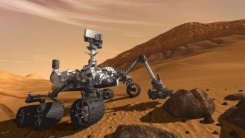 |
|
|
WASHINGTON (AFP) – The US space agency’s unmanned Curiosity rover will explore a mountain on Mars that should read like “a great novel,” revealing if signs of life ever existed on the red planet, NASA said Friday.
The landing site for the 2.5 billion dollar Mars Science Laboratory was unveiled the day after the 30-year shuttle era ended with the return to Earth of Atlantis after its final mission to the International Space Station.
Clues sent home from Mars are important to NASA as it aims to build a spaceship capable of toting humans there by 2030, while private companies race to replace the shuttle with a capsule suitable for low-Earth orbit.
More than 150 scientists have spent years whittling down the landing site for Curiosity, the largest US rover ever, set to launch later this year and land in August 2012.
From an initial set of 30 potential spots, they finally decided on the Gale crater, which contains a five kilometer (three mile) high mountain, over its leading rival the Eberswalde crater, which is home to a dried-up river delta.
“In the end we picked the one that felt best,” said John Grotzinger, MSL project scientist at NASA’s Jet Propulsion Laboratory.
“This could be the tallest mountain in the solar system that we could actually climb with a rover,” he said.
The mountain, tucked inside the 154 kilometer (96 mile) wide crater, reaches higher than any peak in the continental United States but is shaped like a broad mound so the six-wheeled rover can climb at least halfway up.
When Curiosity arrives over Mars, the car-sized craft will be lowered onto a flat part of the crater with the help of a rocket-powered sky crane, while a camera on the bottom of the rover snaps high resolution images of the terrain beneath.
The rover will carry a host of cameras and 10 science instruments, as well as a potent laser beam, drill and robotic arm.
It is meant to last two years, but NASA hopes that like other some of its other rovers in the past, Curiosity will outlive its expected potential.
“If we live longer we may be able to go higher and higher up the mountain,” said Grotzinger.
What scientists are hoping to find are clues from the minerals in the layers about what kind of water was there and if any microbial life forms may have been able to survive.
John Grant, a geologist at the Smithsonian Air and Space Museum, described the mountain as “this enormous stack… of layered material which represents the opportunity to literally read chapters in a book of the history of past deposition on Mars.”
Minerals in clays and sulfates at the base of the mountain are of particular interest, according to Dawn Sumner, a geologist at University of California, Davis.
“We expect to find variations in those minerals which will tell us about the water, how concentrated it was, whether it evaporated, and the sources of the water,” she said.
“And that will give us the history of some of the ancient environments on Mars, how those changed, and help us evaluate the habitability of the planet.”
Sumner said the area also contains signs that water once flowed down the mountain, cutting a canyon into the rocks, an event that “represents an environment that could have been habitable.
In all, the rocks could tell a story that spans hundreds of millions of years.
“What we have learned from 150 years of exploration, is that if you start at the bottom of the pile of layers and you go to the top, it is like reading a novel,” said Grotzinger, referring to the first expedition through the Grand Canyon in 1969.
© AFP — Published at Activist Post with license
“And we think Gale crater is going to be a great novel about the early environmental evolution of Mars that offers strong prospects potentially for the discovery of habitable environments and maybe even a shot at potentially discovering organic compounds.”
The rover is not a “life-detection mission and we cannot look for fossils, microbial fossils of any type,” he added. “But we can look for organic carbon that may be observed there,” which would indicate some life once existed.
linkwithin_text=’Related Articles:’



Be the first to comment on "NASA says Mars mountain will read like ‘a great novel’"